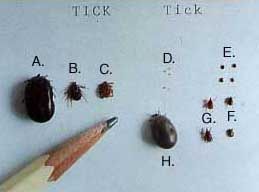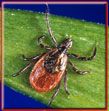
Call Today 1-978-225-6002
We are the
best resource for Tick And Mosquito Spraying for West Newbury
Massachusetts
TICK SPRAYING .COM Provides the very best in tick and mosquito spraying services in West Newbury MA 01985, please click here to request a quote. Due to the volume of requests for tick spraying service outside of West Newbury MA
we have provided links to other companies that provide tick spraying or tick control services. Tick borne diseases like Lyme Disease have increased greatly over the years in West Newbury MA
almost everyone knows someone who has contracted Lyme Disease. Lyme disease isn't the only disease transmitted by ticks. Anaplasmosis, Babesiosis are also transmitted by ticks. Due to the ticks life cycle we are all at risk spring through fall if we go outside or our pets do.

PICTURE COURTESY OF THE LYME DISEASE
FOUNDATION
Dog ticks and black-legged ticks
compared to a pencil
| Dog Ticks | Black-Legged Ticks |
| A. Engorged female | D. Larvae |
| B. Female | E. Nymphs |
| C. Male | F. Males |
| G. Females | |
| H. Engorged female |

Properties that border woods, fields present the most risk. When ticks are detected we will treat:
- The first 10-15’ border of grass that meets the woods, plus 10'-20' into the woods.
- Tall grass and weeds
- Low brush (up to 36")
- Groundcover in shaded areas
- Thickly landscaped beds where where appropriate.
- Rock Walls , Brush & Woodpiles
- Under porches and sheds.
Lyme disease is a threat to dogs and cats. Almost every pet owner in West Newbury Massachusetts has seen a tick on their pet at some point. The dog tick (Dermacentor variabilis) and the deer tick (Ixodes scapularis) are the two most common ticks in West Newbury MA. Deer ticks are small, about the size of a pinhead Lyme disease is caused by the bite of an infected deer tick. The tick life cycle has four stages and completes in 2 years. All through out their life cycle they need blood meals to pass from larva to adult. This is where mammals play a role. Ticks can easily go undetected on you or your pet for days, which is why we recommend doing tick checks daily. Pets can carry ticks into your house and potentially expose everyone to a tick bite. Ticks can live in a West Newbury MA home for up to 3 days before dying,due to a lack of moisture. If you let your pet on your bed or furniture you risk a tick bite. Ticks can easily migrate to you and go undetected. By
implementing a tick management program within your yard you will drastically lower you and your pet’s exposure to ticks.
Amesbury MA 01913
Andover MA 01810
Bedford MA 01730
Belmont MA 02478
Beverly MA 01915
Bradford MA 01835
Burlington MA 01830
Byfield MA 01922
Boxford MA 01921
Danvers MA 01923
Essex MA 01929
Groveland MA 01834
Georgetown, MA 01833
Gloucester MA 01930
Hamilton MA 01936
Haverhill MA 01830
Ipswich MA 01938
Lexington MA 02420
Lincoln MA 01773
Lynnfield MA 01940
Manchester MA 01944
Marblehead MA 01945
Merrimac MA 01860
Middleton MA 01949
Newbury MA 01951
Newburyport MA 01950
Newton MA 02460
North Andover MA 01845
Peabody MA 01960
Salem MA 01970
Plum Island MA 01950
Rockport MA 01966
Rowley MA 01969
Salisbury MA 01952
South Hamilton MA 01982
Topsfield MA 01983
Wenham MA 01983
West Newbury MA 01985
Winchester MA 01890
Woburn MA 01801
Ticks are active in North Andover MA above 32 degrees. You don’t feel it when a tick bites you, this is why it is very important to do frequent tick checks during and after being outdoors. A daily tick check is still the best protection against Lyme disease and tick-borne illnesses.
How much does it cost to spray ticks and how many treatments are needed for West Newbury MA 01985 ?
Property size and how much tick habitat requires treatment determine the cost. Most programs require treatments spring, summer and fall at different times of the tick’s life cycle. Tick density and the population of host animals varies by location so it ultimately determine how many treatments will be required.
For example, on thickly wooded, tick-dense properties we may need to add additional services and space more treatments closer together. Usually if you have tick habitat and host animals, then it’s a good chance your neighbors do also.
Sampling the Property for Ticks
Drag sampling is a good way to approximate tick presence. This is done by dragging a 3ft square white sheet over the areas that ticks would be found, i.e. wood lines, (up to 3’), tall grass, the first 10’ border of grass that meets the woods, etc. Ticks looking for a host will attach themselves to the drag cloth. When you turn the cloth over after dragging it 50-100 feet you may find ticks crawling on the cloth. This sampling has limitations depending on time of year, growth stages, and weather conditions. If you sample when ticks are not very active, a misleading negative finding may result. Also, a very small amount of the total tick population can be collected at any time. You can also get false negatives depending on time of year. One suggestion is to drag sample the same areas on 3 to 4 different days when conditions are favorable. This will give you a more accurate estimation.


